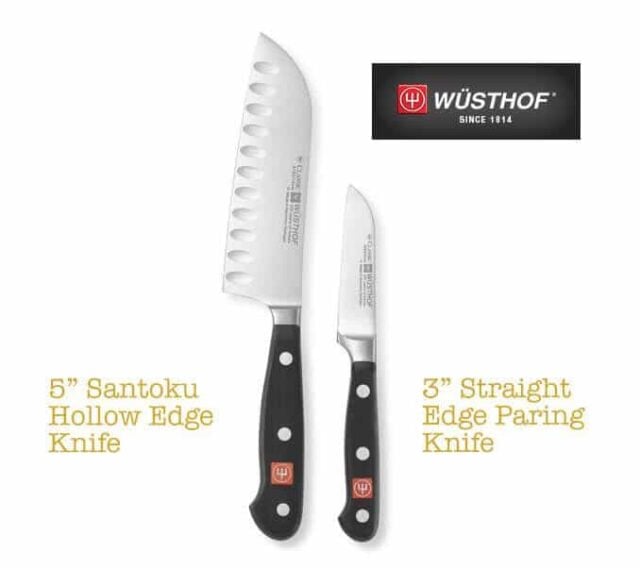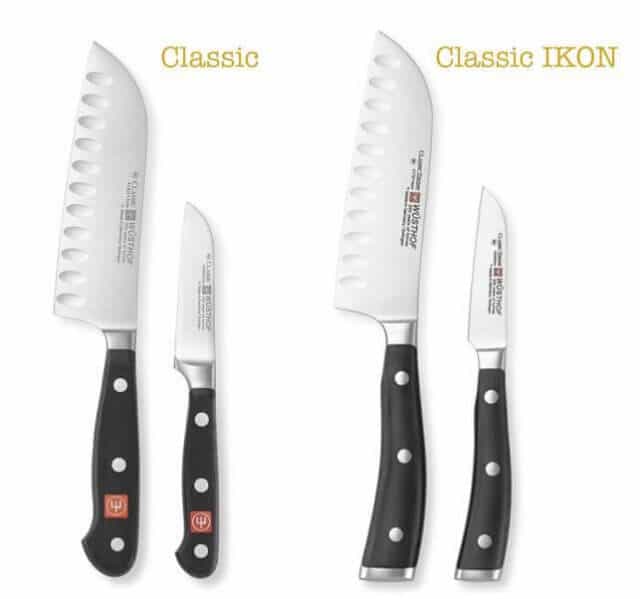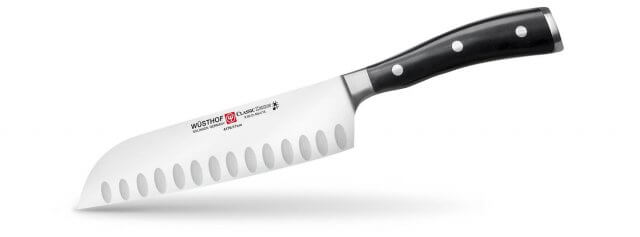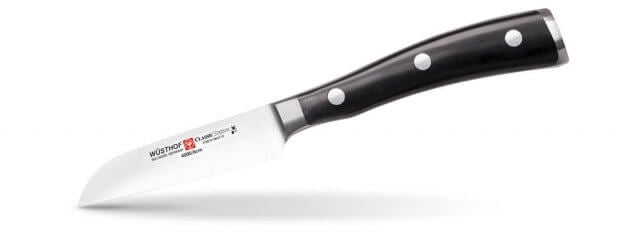Wüsthof 2-Piece Mini Asian Knife Set Review & Giveaway
This post may contain affiliate links. Please read our
disclosure policy
for more information.

This review for the Wüsthof 2-Piece Mini Asian Knife Set includes both PROs and CONs of the product. We tested the knife set for 2 months prior to this review.
Wüsthof 2-Piece Mini Asian Knife Set Review
We’ve been using the Wüsthof 5″ Hollow Edge Santoku and the 3″ Flat Cut Paring Knife (both from the Wüsthof 2-Piece Mini Asian Knife Set), putting it through the rigors of prepping everyday family meals and constant recipe testing at Steamy Kitchen.
Two Versions of the Mini Asian Knife Set
There are 2 versions of this knife: Classic and Classic IKON.

Same blade, same durable, non-porous polyoxymethylene material handle. Here are the differences:
Classic
- Traditional, best-selling Wüsthof collection
- Square-ish finish on handle
- PRO: This set sells for around $99 at both Williams Sonoma and Sur La Table, about $40 cheaper than the Classic IKON
Classic IKON
*Note, the Classic IKON is different from the plain IKON, which is made from real African Blackwood.
- PRO: Ergonomic, curvy handle. Feels good in hand.
- CON: This set sells for around $139 at Williams Sonoma and Sur La Table. Is the handle design worth nearly half the price of the Classic? My answer is “no,” and I’ll tell you why in just a bit. First, let’s talk about the blade.
The Blade Specs
The Wüsthof 2-Piece Mini Asian Knife Set is made from with X50CrMoV15 stainless steel, with Precision Edge Technology. Yes, technology is the spot-on word to describe this German knife company that began in 1814.
Wüsthof’s computer-controlled robotic machines sharpens each knife for a smoother, sharper edge than any other method. The result is an edge that stays sharp, 2x longer, according to Wüsthof.
Rockwell Hardness of 58.
PRO: A finer, sharper edge angle, which is traditional of most Asian knives. The blade stays sharp, twice as long as their competitors.
Let’s go into each knife:
5″ Santoku Hollow Edge Knife

The scalloped or hollow edge is great for cutting thin slices of vegetables, to reduce friction and stick. Vegetables fall off the blade, and onto the cutting board for faster and more efficient cutting.
Much of Asian cooking, especially stir-fries require even, thin slices of ingredients, so that everything cooks evenly. That’s why Santoku knives are so designed with the hollow edge and flat blade (vs. curved blade made for “rocking” motion of mincing). The flat blade helps you slice in one even motion.
The angle of edge is 10º on each side.
PRO: Wüsthof’s Santoku is light. About 4 ounces, which is a great weight for cutting small vegetables and fruit. The lightness makes the knife makes you more nimble and your hands less tired when cutting for everyday cooking. In contrast, traditional European style knives have a thicker blade, and are heavier. Heavier knives are great for mincing using the rocking motion, and for cutting through thin, small bones.
The blade of this knife is 5″ long. It’s perfect for smaller vegetables and fruit: skinny carrots, apples, broccoli, garlic slices, shallot, green onion, Asian leafy greens etc. The knife is not made for cutting larger vegetables and fruit, like fat potatoes, daikon, melons, squash. Choose a longer, larger santoku knife for those ingredients.
PRO: The thin, super sharp blade at 10º on each side lets you cut paper-thin slices with amazing precision.
CON: All of Wüsthof’s Santoku knives’ hollow edge comes very close to the blade’s edge. In my opinion, too close. When you sharpen a blade, you are actually creating a new edge – which means removing steel. As you sharpen over time, the hollow indents will come even closer to the edge, and may even become the edge.
Wüsthof 3″ Asian Paring Knife

This paring knife has a flat edge that comes to a beak-like point. Actually, both the santoku and this paring knife have the “sheepsfoot” point. The blade is 3″ long.
This knife is sharpened to 14º on each side.
PRO: The shape of the blade is perfect for peeling in-hand. The blade’s edge cuts evenly and maximizes the amount of blade cutting your ingredient. In contrast, if you use a European style paring knife with a “belly” curve to peel an apple, your blade’s belly is the only part that’s cutting. Great for peeling garlic, shallots, onion skin. Perfect for slicing strawberries.
PRO: The handle is a generous 4″ long. Some paring knife handles are just too short and end up digging into my palm.
PRO: Light! The knife weighs 2.4 ounces. This makes it easier for hand-work and delicate cutting.
Why I recommend the Classic instead of Classic IKON
Wüsthof’s Classic line is aptly named, it’s a classic design that professional chefs and cooks worldwide have been enjoying since 1814.
The Classic IKON shape is just a little more comfortable, ergonomic. It fits my hand a little better. Both handles are made of same material. Is it worth an additional $40 for the handle shape?
In my opinion, no. Not for the 5″ santoku, which is meant for smaller vegetables and fruit, prepping for everyday meals.
The handle shape of the Classic is just fine for me. I am not slicing 10 pounds of carrots everyday, and I am not peeling a bushel of apples. Hey, if professional chefs have been using Wüsthof Classic for 200 years without complaint, so can I! 🙂
If I happen to be tasked with 10 pounds of carrots to slice, I’d use a food processor or a mandolin (this one is my favorite). If I had to choose a knife to slice 10 pounds of carrots, I’d use a larger, longer santoku knife that weighs a bit more, maybe a 9″ knife and allow the weight of the knife to help me get through all the carrots.
Save your $40 and get a another knife! Here’s another great Wüsthof knife that we reviewed recently and that I also use everyday.
Wüsthof 2-Piece Mini Asian Knife Set Giveaway
Wüsthof will send the winner 2-piece Mini Asian Classic Knife set.
This post may contain affiliate links. Please read our
disclosure policy
for more information.
This post may contain affiliate links. Please read our
disclosure policy
for more information.

This review for the Wüsthof 2-Piece Mini Asian Knife Set includes both PROs and CONs of the product. We tested the knife set for 2 months prior to this review.
Wüsthof 2-Piece Mini Asian Knife Set Review
We’ve been using the Wüsthof 5″ Hollow Edge Santoku and the 3″ Flat Cut Paring Knife (both from the Wüsthof 2-Piece Mini Asian Knife Set), putting it through the rigors of prepping everyday family meals and constant recipe testing at Steamy Kitchen.
Two Versions of the Mini Asian Knife Set
There are 2 versions of this knife: Classic and Classic IKON.

Same blade, same durable, non-porous polyoxymethylene material handle. Here are the differences:
Classic
- Traditional, best-selling Wüsthof collection
- Square-ish finish on handle
- PRO: This set sells for around $99 at both Williams Sonoma and Sur La Table, about $40 cheaper than the Classic IKON
Classic IKON
*Note, the Classic IKON is different from the plain IKON, which is made from real African Blackwood.
- PRO: Ergonomic, curvy handle. Feels good in hand.
- CON: This set sells for around $139 at Williams Sonoma and Sur La Table. Is the handle design worth nearly half the price of the Classic? My answer is “no,” and I’ll tell you why in just a bit. First, let’s talk about the blade.
The Blade Specs
The Wüsthof 2-Piece Mini Asian Knife Set is made from with X50CrMoV15 stainless steel, with Precision Edge Technology. Yes, technology is the spot-on word to describe this German knife company that began in 1814.
Wüsthof’s computer-controlled robotic machines sharpens each knife for a smoother, sharper edge than any other method. The result is an edge that stays sharp, 2x longer, according to Wüsthof.
Rockwell Hardness of 58.
PRO: A finer, sharper edge angle, which is traditional of most Asian knives. The blade stays sharp, twice as long as their competitors.
Let’s go into each knife:
5″ Santoku Hollow Edge Knife

The scalloped or hollow edge is great for cutting thin slices of vegetables, to reduce friction and stick. Vegetables fall off the blade, and onto the cutting board for faster and more efficient cutting.
Much of Asian cooking, especially stir-fries require even, thin slices of ingredients, so that everything cooks evenly. That’s why Santoku knives are so designed with the hollow edge and flat blade (vs. curved blade made for “rocking” motion of mincing). The flat blade helps you slice in one even motion.
The angle of edge is 10º on each side.
PRO: Wüsthof’s Santoku is light. About 4 ounces, which is a great weight for cutting small vegetables and fruit. The lightness makes the knife makes you more nimble and your hands less tired when cutting for everyday cooking. In contrast, traditional European style knives have a thicker blade, and are heavier. Heavier knives are great for mincing using the rocking motion, and for cutting through thin, small bones.
The blade of this knife is 5″ long. It’s perfect for smaller vegetables and fruit: skinny carrots, apples, broccoli, garlic slices, shallot, green onion, Asian leafy greens etc. The knife is not made for cutting larger vegetables and fruit, like fat potatoes, daikon, melons, squash. Choose a longer, larger santoku knife for those ingredients.
PRO: The thin, super sharp blade at 10º on each side lets you cut paper-thin slices with amazing precision.
CON: All of Wüsthof’s Santoku knives’ hollow edge comes very close to the blade’s edge. In my opinion, too close. When you sharpen a blade, you are actually creating a new edge – which means removing steel. As you sharpen over time, the hollow indents will come even closer to the edge, and may even become the edge.
Wüsthof 3″ Asian Paring Knife

This paring knife has a flat edge that comes to a beak-like point. Actually, both the santoku and this paring knife have the “sheepsfoot” point. The blade is 3″ long.
This knife is sharpened to 14º on each side.
PRO: The shape of the blade is perfect for peeling in-hand. The blade’s edge cuts evenly and maximizes the amount of blade cutting your ingredient. In contrast, if you use a European style paring knife with a “belly” curve to peel an apple, your blade’s belly is the only part that’s cutting. Great for peeling garlic, shallots, onion skin. Perfect for slicing strawberries.
PRO: The handle is a generous 4″ long. Some paring knife handles are just too short and end up digging into my palm.
PRO: Light! The knife weighs 2.4 ounces. This makes it easier for hand-work and delicate cutting.
Why I recommend the Classic instead of Classic IKON
Wüsthof’s Classic line is aptly named, it’s a classic design that professional chefs and cooks worldwide have been enjoying since 1814.
The Classic IKON shape is just a little more comfortable, ergonomic. It fits my hand a little better. Both handles are made of same material. Is it worth an additional $40 for the handle shape?
In my opinion, no. Not for the 5″ santoku, which is meant for smaller vegetables and fruit, prepping for everyday meals.
The handle shape of the Classic is just fine for me. I am not slicing 10 pounds of carrots everyday, and I am not peeling a bushel of apples. Hey, if professional chefs have been using Wüsthof Classic for 200 years without complaint, so can I! 🙂
If I happen to be tasked with 10 pounds of carrots to slice, I’d use a food processor or a mandolin (this one is my favorite). If I had to choose a knife to slice 10 pounds of carrots, I’d use a larger, longer santoku knife that weighs a bit more, maybe a 9″ knife and allow the weight of the knife to help me get through all the carrots.
Save your $40 and get a another knife! Here’s another great Wüsthof knife that we reviewed recently and that I also use everyday.
Wüsthof 2-Piece Mini Asian Knife Set Giveaway
Wüsthof will send the winner 2-piece Mini Asian Classic Knife set.
This post may contain affiliate links. Please read our
disclosure policy
for more information.









